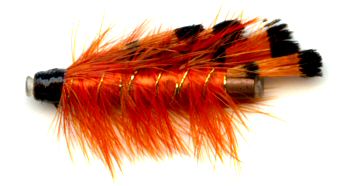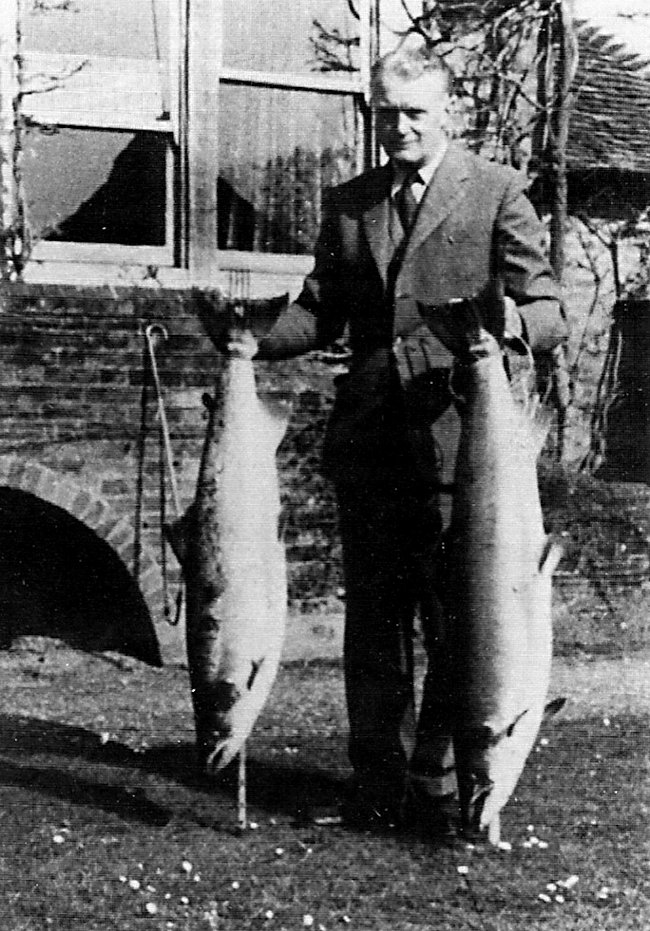The General Practitioner 1 Inch Copper Tube Fly
The General Practitioner was developed in the early 1950's by Lt Colonel Esmond Drury as an imitation of a shrimp to be used on the River Test. Anglers on that salmon fishing 'beat' used to use live shrimp on a hook to fish for salmon.

SALTWATER, SALMON & STEELHEAD TUBE FLY
$US each. Price does not include hooks.
The land owners along the River Test banned this practice so Drury developed this fly to imitate the native Northern Shrimp. He tied the fly on size 2 hooks but found that the smaller hooks caught more fish especially in the more shallow water areas. The original consisted of golden-pheasant body feathers and orange fur. He called this fly G.P. at first because of the golden pheasant feathers that went to make up the large part of this pattern. The General Practitioner has a better record than most, fished on a floating line at low levels in the summer. It has proved very effective on a wide range of waters from America, Canada, Scandinavia, Britain and Iceland. The name changed to General Practitioner because of its effectiveness. It is a very popular and effective fly in brownish and murky rivers.

Fly Fisherman Lt Colonel Esmond Drury designer of the General Practitioner Salmon Fly pattern with a brace of salmon caught on the River Wye
SHRIMP SALMON FLIES
Some shrimps turn a brighter color during their summer mating seasons. Shrimps swim in energetic burst, surging up from the river bed and diving back down just as quick. This type of 'sink and draw' is easy to reproduce when you fish with a weighted shrimp on a floating line. Cast the fly and let it sink until you think it is at, or near, the bed of the river or lake. As you retrieve the line the shrimp fly will rise up towards the surface. Stop and the shrimp will dive back down to the bottom. A shrimp fished with six inch pulls followed by two second pauses can be very tantalizing to a trout. If you should fail to get results try longer pulls at greater intervals. Steelheads, Chinooks, Chums, Char, Coho and Sea Trout will feed on shrimp and prawns when available. These fish often retain the search image of these crustaceans long after they leave the Ocean and enter freshwater. These are must have flies for Alaska, Kamchatka, British Columbia and lower 48.
SHRIMPS & PRAWNS
There are about thirty species of shrimps (the smaller ones are sometimes referred to as Prawns in Britain) in the North Atlantic Ocean. The most numerous is the Northern or Pink Shrimp (Pandalus borealis). It ranges from the Gulf of Maine, across the Atlantic and into the Barents, Norwegian and North Sea. It is pale scarlet and has a hard outer shell with long antennae and large dark eyes. It can swim rapidly over short distances because of the appendages on its tail that act like paddles. The females migrate to shallower costal areas just prior to spawning. These shrimps can live for more than five years. They are one of those strange animals that are both sexes. It is a hermaphrodite. It contains both male and female reproductive organs. The Northern Shrimp is male until it spawns for the first time when it is about three years old and then changes sex into a female. Because females have lived longer than the males they are generally bigger than the males. European salmon anglers have been using shrimp imitations for years. It is only recently that North American salmon fly fishers have started to widely use shrimp flies. A practice that should be encouraged as these flies can give hours of good sport.

